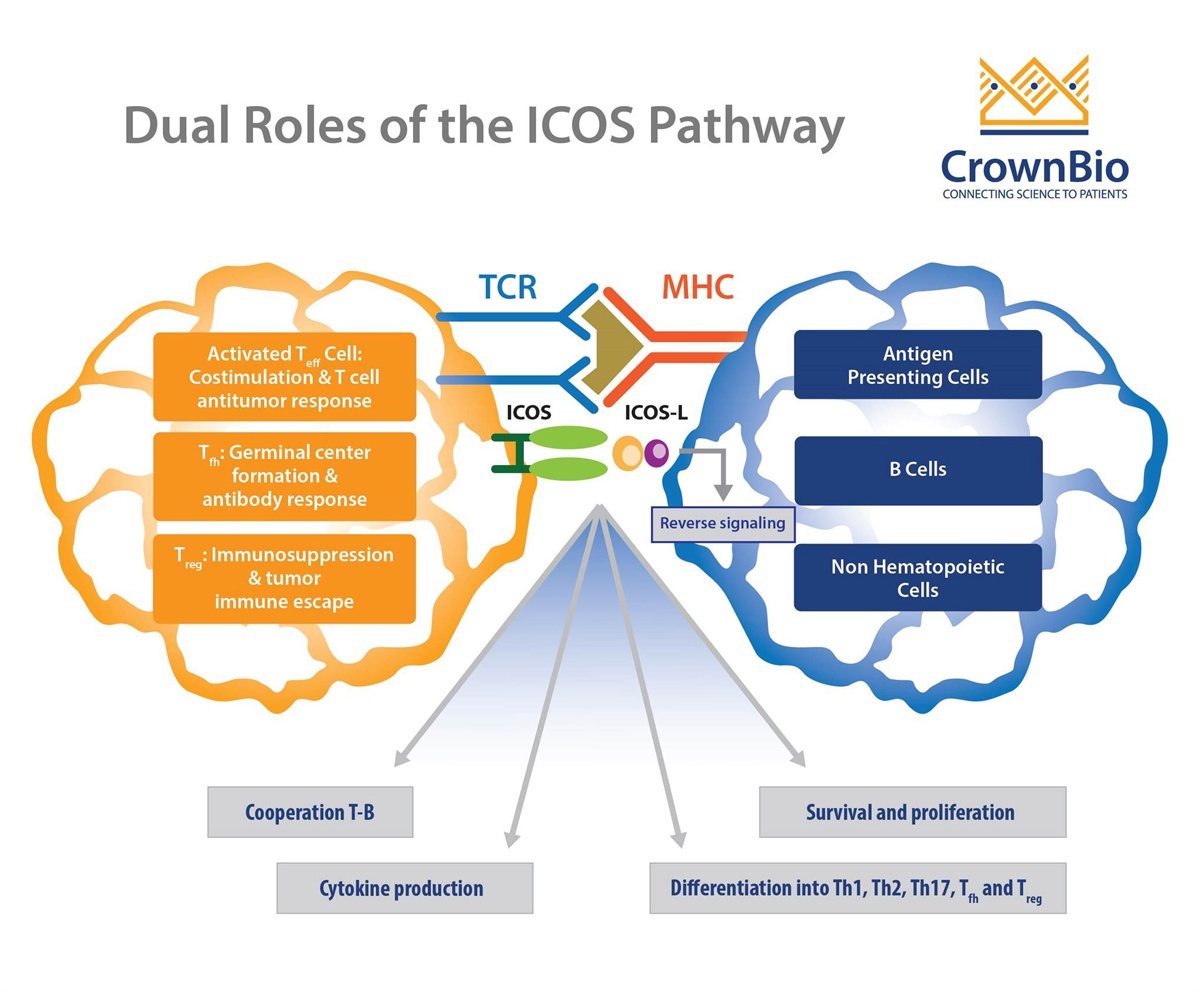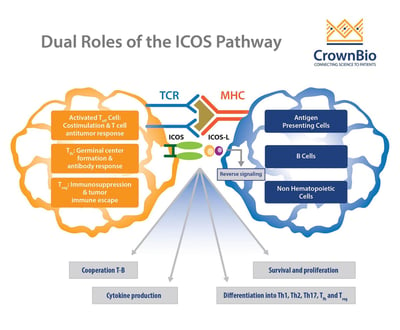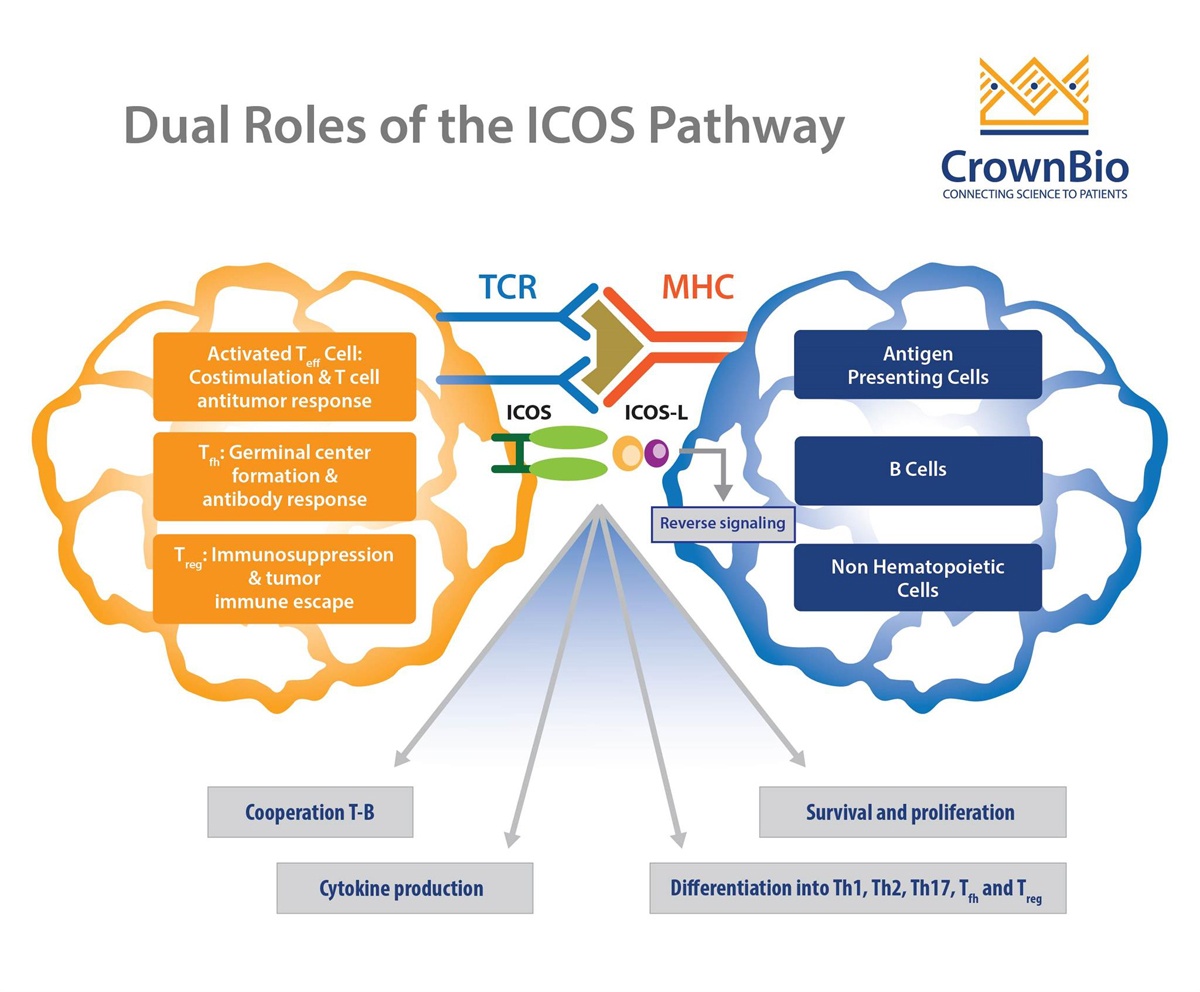ICOS: Immunostimulatory or Immunosuppressive Target?

 The rise of immunotherapy has brought many new targets to the forefront of oncology drug development. One promising new avenue of investigation is ICOS, an immune checkpoint expressed on activated T cells, which has opposing functions in sustaining T cell activation and in Treg suppressive activity.
The rise of immunotherapy has brought many new targets to the forefront of oncology drug development. One promising new avenue of investigation is ICOS, an immune checkpoint expressed on activated T cells, which has opposing functions in sustaining T cell activation and in Treg suppressive activity.
This introductory review explores the dual roles of ICOS and how these can be targeted via different immunotherapeutic approaches.
ICOS: A Member of the CD28/CTLA-4 Family, Expressed on Activated T Cells
The T cell-specific cell-surface receptors CD28 and CTLA-4 are important regulators of the immune system:
- CD28 potently enhances T cell functions that are essential for an effective antigen-specific immune response
- The homologous CTLA-4 counteracts CD28-mediated costimulatory signals and impairs T cell activation, thereby preventing an otherwise fatal overstimulation of the lymphoid system.
A third member of the CD28/CTLA-4 family is the inducible co-stimulator (ICOS). ICOS is a homodimeric protein which is expressed on activated T cells, and only at low levels on resting, naïve T cells. ICOS binds specifically to its ligand (ICOS-L), also known as B7-related protein-1 (B7RP-1), which is expressed constitutively on B cells.
ICOS Signaling, T Cell Activation, and Effector Functions
During the immune response, T cells are optimally activated in secondary lymphoid tissues to properly migrate into areas of inflamed tissue. Upon antigen recognition, via the T cell receptor (TCR)/CD3 antigen (CD3) complex, a second co-stimulatory signal from APCs is necessary for the activation of naive T cells.
T cell activation induces co-stimulatory molecules, including the ICOS/Activation-Inducible Lymphocyte Immunomediatory Molecule (AILIM). ICOS-mediated signaling contributes mainly to the regulation of activated T cells and to effector T cell functions, and the potency of ICOS is enhanced following its ligation to ICOS-L.
ICOS and Treg Homeostasis
ICOS is highly expressed on tonsillar T cells, which are closely associated with B cells in the apical light zone of germinal centers, where terminal B cell maturation occurs. In the absence of ICOS, germinal center formation is impaired and immunoglobulin class switching is defective (1,2).
In addition to providing help for B cells, and acting as a key costimulatory signal for T cell proliferation and survival, ICOS also regulates development and response of T follicular helper (Tfh), Th1, Th2, and Th17 cells while playing roles in the maintenance of memory effector T cells and regulatory T cells (Treg) homeostasis.
Dual ICOS Role Provides Multiple Opportunities to Enhance Antitumor Immunity
Due to its dual role in sustaining T cell activation and effector functions, as well as its connection with Treg suppressive activity, targeting ICOS/ICOS-L represents an attractive approach to enhancing antitumor immunity.
In the clinic, downregulation of ICOS has been shown in colon cancer patients, while the expression of ICOS in tumors was shown to be associated with greater survival in melanoma patients.
In opposition, it has been demonstrated that the selective expression of ICOS on a “hyperactivated” Treg intra-tumoral population strongly inhibited T cell response through IL-10-mediated APC suppression.
Moreover, it has been shown that ICOS-L is expressed on both cultured and freshly isolated melanoma cells from Stage IV melanoma patients, and can provide co-stimulation through ICOS for the activation and expansion of Tregs in the tumor microenvironment. This provides another mechanism of escape from immune surveillance.
Both Agonistic and Antagonistic ICOS Antibodies Under Development
Both antagonist and agonist antibodies are of interest in targeting the ICOS/ICOS-L pathway for cancer treatment.
Currently, two agonists and one antagonist mAb are being evaluated in Phase I/II trials. Efficacy, safety, and combination strategies with anti-ICOS agonists or antagonists have yet to be specified.
ICOS Agonist mAbs:
- GSK3359609 (GlaxoSmithKline) is being evaluated in a Phase I open label study, both alone and in combination with pembrolizumab in subjects with selected advanced solid tumors (INDUCE-1, NCT02723955).
- JTX-2011 (Jounce Therapeutics) is being evaluated in a Phase I/II, open label study, alone or in combination with nivolumab in subjects with advanced solid tumors (ICONIC, NCT02904226)
ICOS Antagonist mAbs:
- • MEDI-570 (Medimmune, NCT02520791) is being evaluated in a Phase I trial in patients with relapsed/refractory peripheral T cell lymphoma (PTCL) follicular variants and angioimmunoblastic T cell lymphoma (AITL). MEDI-570 is a human IgG1κ mAb directed against the ligand-binding domain of ICOS, which can promote antibody-dependent cellular cytotoxicity (ADCC) activity against ICOS+ T cells.
As with all new immuno-oncology targets, a thorough understanding of ICOS signaling and its multiple T cell roles will help decide which therapeutic routes and options may bring the most benefit to patients.
References and Further Reading:
- Breitfeld et al. Follicular B helper T cells express CXC chemokine receptor 5, localize to B cell follicles, and support immunoglobulin production. J Exp Med 2000; 192(11):1545-52.
- Schaerli et al. CXC chemokine receptor 5 expression defines follicular homing T cells with B cell helper function. J Exp Med 2000;192(11):1553-62.


